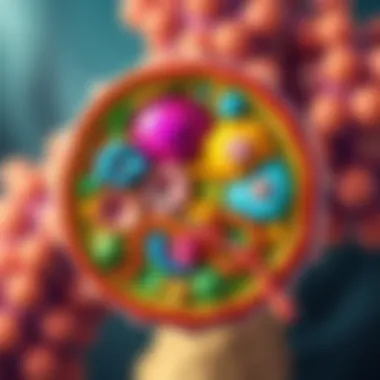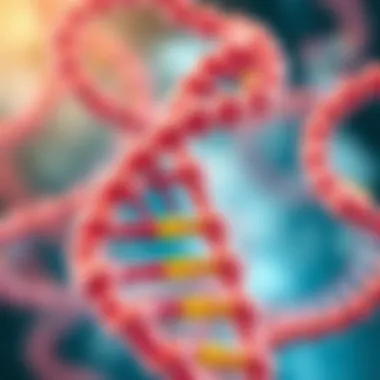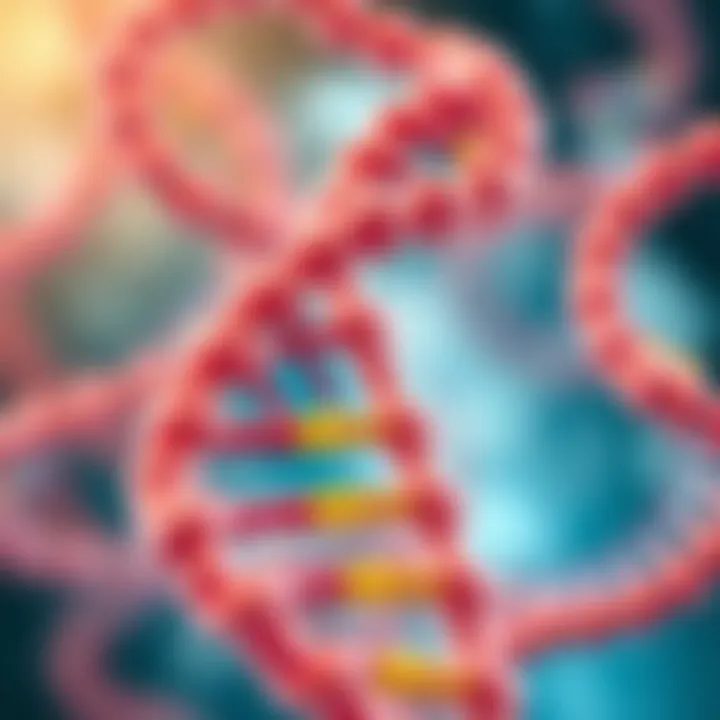Exploring Key Concepts in Biology: An In-Depth Analysis


Intro
Biology, the intricate study of life, unveils the fascinating mechanisms that govern existence, from the tiniest cells to massive ecosystems. At its core, biological principles lay the groundwork for understanding the myriad forms of life and their interplay with the environment. This article endeavors to break down these principles, providing insights into essential concepts like cell structure, genetic frameworks, and ecological relationships, all while reflecting on evolution’s significant role in shaping life as we see it today.
Understanding biology is crucial not just for students and professionals pursuing careers in life sciences but also for anyone intrigued by the natural world. Each component of this complex tapestry offers a piece of the puzzle reflecting life's processes, and grasping these principles sheds light on our existence and future.
In this overview, we will delve into:
- Cell Structure: Exploring the fundamental building blocks of life.
- Genetic Mechanisms: Understanding heredity and variation in species.
- Ecological Interactions: Analyzing the relationships among organisms and their environments.
- Evolutionary Theory: Unpacking the principles of natural selection and adaptation.
The importance of these topics goes beyond academic interest; they impact health care, environmental conservation, and even technology. As we embark on this intellectual journey, we aim to demystify biological concepts into accessible segments, providing clarity and insight into how these principles shape both the natural world and human advancement.
Fundamentals of Biology
Biology serves as the bedrock of our understanding of life. It encompasses a broad spectrum of concepts that are critical for dissecting the intricacies of living organisms. The fundamentals of biology provide essential tools for analyzing the mechanisms that govern life itself, from cellular interactions to ecosystem dynamics. This section highlights the foundational elements and their relevance, demonstrating how these principles interconnect various fields of science and play a vital role in society.
Definition and Scope
When defining the scope of biology, it’s essential to recognize its multidimensional nature. Biology is not merely a study of organisms; it is an ever-evolving field that examines the relationships, structures, functions, and processes that define life. The discipline can be categorized into several branches, including but not limited to cell biology, ecology, genetics, and evolution. Each of these branches contributes to our collective knowledge, allowing for a nuanced understanding of the life sciences.
For example, consider how cellular biology dives into the machinery of life at a microscopic level - studying cell structures like organelles, and understanding their functions. This knowledge then links to genetics, where the focus shifts to DNA and heredity. This interplay creates a holistic view of biology, making it crucial for students and professionals alike. Furthermore, the insights gleaned from biology have practical applications in fields such as medicine, biotechnology, and environmental science.
Importance in Science and Society
Biology is not just an academic discipline; it is intrinsically intertwined with everyday life. The relevance of biological principles extends beyond the confines of the laboratory into the heart of societal applications. Understanding biological processes helps us tackle some of the pressing challenges of our times. For instance:
- Health and Medicine: Advances in biological research have led to breakthroughs in treatments for diseases, vaccine development, and personalized medicine. Knowledge of genetics is fundamental for understanding hereditary diseases and optimizing treatment approaches.
- Environmental Conservation: With ongoing climate change and biodiversity loss, the application of ecological principles is vital for effective conservation strategies. Recognizing interspecies relationships informs policies aimed at protecting vulnerable ecosystems.
- Agriculture: Biological research facilitates the development of sustainable farming practices, improving food security while taking care of natural resources.
“Biology is the only science in which multiplication is the same thing as division.” – Louis Agassiz
Cell Biology
Cell biology stands at the core of biological sciences, playing a pivotal role in understanding the fundamental unit of life: the cell. This discipline encompasses a multitude of aspects related to the structure, function, and processes of cells, which are vital for all living organisms. A keen grasp of cell biology is essential, not just for students of the life sciences, but also for professionals in medicine, environmental science, and biotechnology. The insights gained in this field contribute to advancements in health, the understanding of diseases, and the development of novel technologies.
Structure and Function of Cells
The Cell Theory
The Cell Theory forms the foundation of modern biology, articulating three key principles: all living organisms are composed of cells, cells are the basic unit of life, and all cells arise from pre-existing cells. This theory fundamentally shifted the perspective on biology, recognizing cells as the building blocks of life. What makes this theory compelling is its universality—applicable across various life forms, it serves as a unifying concept in biology.
One notable characteristic of the Cell Theory is its empirical basis, supported by a vast body of observational evidence. It enhances our understanding of how organisms grow, reproduce, and maintain homeostasis. By integrating these foundational ideas into our study of cell biology, we build a solid groundwork essential for exploring more complex biological processes.
On the flip side, while the Cell Theory is robust, it does have limitations. It primarily focuses on cellular structures and fails to encompass the intricate interactions between cells and their environments. Hence, while useful, the Cell Theory must be viewed alongside more advanced frameworks of cellular interactions and signaling.
Prokaryotic vs Eukaryotic Cells
Diving into the world of cell biology reveals a major categorization: prokaryotic and eukaryotic cells. This classification holds significance for understanding the diversity of life forms. Prokaryotic cells, often simpler and smaller, lack a nucleus and membrane-bound organelles. Examples include bacteria, which have unique mechanisms of survival and reproduction that are quite different from their eukaryotic counterparts. Their simplicity makes them a popular choice for studies in molecular biology, especially in genetic engineering and biotechnology.
Eukaryotic cells, on the other hand, house a nucleus and various organelles, making them more complex. These cells form the basis of multicellular organisms, including animals and plants. Importantly, this complexity allows for specialized cell functions, thereby enabling the development of intricate systems, such as tissues and organs. However, this complexity also means that understanding eukaryotic cells demands more sophisticated approaches, often necessitating advanced laboratory techniques.
Cellular Processes
Cell Division and Mitosis
Cell division is a critical process for growth, repair, and reproduction in all living organisms. Mitosis, a specific type of cell division, allows for the replication of somatic cells, resulting in two genetically identical daughter cells. This process provides a fascinating avenue for studying how organisms maintain their genetic integrity throughout cellular life cycles.
One prominent feature of mitosis is its highly regulated framework, ensuring that the dividing cells distribute their genetic material accurately. This regulation is crucial; any errors can lead to a host of issues, including cancer. Its well-known stages, including prophase, metaphase, anaphase, and telophase, create a captivating narrative for students and professionals alike, providing insights into the life of a cell.
While the advantages of mitosis are clear, such as efficiency in growth and repair, it is not without its drawbacks. Rapid cell division processes can sometimes lead to unchecked growth, a hallmark of cancerous cell lines, emphasizing the need for ongoing research in this area.
Meiosis and Genetic Variation
Another essential process in cellular biology is meiosis, which is crucial for sexual reproduction. Unlike mitosis, meiosis results in four genetically distinct daughter cells, each with half the chromosomal number of the parent cell. This method not only facilitates genetic diversity but also plays a role in evolution, allowing populations to adapt and thrive in changing environments.
One key characteristic of meiosis is the unique process of crossing over during prophase I. This exchange of genetic material between homologous chromosomes generates new allele combinations, an essential mechanism for evolution. Students often find meiosis fascinating as it reveals how genetic variation occurs, making it a beneficial choice for inclusion in biological discussions.
While meiosis is vital for preserving genetic diversity, it can also lead to complications. Errors during meiosis can result in conditions such as Down syndrome or Turner syndrome, highlighting the balance between genetic variation and genetic stability.
Genetics
Genetics stands as a cornerstone in biology, illuminating the mechanisms of heredity and variation in living organisms. Its significance is underscored not just within the context of scientific inquiry but also in societal applications, such as medicine, agriculture, and conservation. By understanding genetics, we tap into the very essence of life itself, unraveling the intricate dance of genes that dictate traits, behaviors, and susceptibilities to diseases.
In this section, we will delve into the basic principles of heredity, including Mendelian genetics and various patterns of inheritance, followed by molecular-level insights on DNA structure and function, as well as gene expression and regulation. The knowledge of genetics significantly enhances our comprehension of biological phenomena, thereby guiding advancements in therapeutics, biotechnology, and biodiversity preservation.
Basic Principles of Heredity
Mendelian Genetics


Mendelian genetics revolves around the fundamental laws of inheritance as dictated by Gregor Mendel in the 19th century. This branch of genetics is pivotal because it laid the groundwork for our current understanding of how traits are passed from parents to offspring. The key characteristic of Mendelian genetics is the concept of dominant and recessive alleles. It boils down to how one trait can overshadow another, much like how a loud voice can drown out background chatter.
This approach is a beneficial choice for this article as it simplifies complex genetic concepts into manageable ideas. Mendel's work emphasizes observable traits in organisms, making it accessible for students and professionals alike. A unique feature of Mendelian genetics is the use of punnett squares, tools for predicting offspring traits based on parental gene combinations. One advantage is its clarity and straightforwardness; however, its disadvantage lies in its limitation to simple traits, failing to account for polygenic inheritance, where multiple genes influence a single trait.
Patterns of Inheritance
Patterns of inheritance explore the various ways in which traits are transmitted through generations. These include dominant and recessive inheritance, codominance, and incomplete dominance. The key characteristic here is the diversity in genetic presentations one may observe in offspring compared to their parents. This variety is a beneficial aspect for understanding complex traits and diseases, making it a rich topic for exploration in this article.
A notable unique feature of patterns of inheritance is their role in real-world applications such as genetic counseling, where families seek guidance regarding hereditary conditions. The advantages include enhanced predictive capabilities regarding traits in offspring, but there are also disadvantages, including the complexities arising from non-Mendelian patterns such as epistasis or environmental influences on gene expression.
Molecular Genetics
DNA Structure and Function
Molecular genetics drills down to the molecular basis of heredity, centering on the structure and function of DNA. The double helix structure of DNA, with its complementary pairing of nucleotides, is a central feature that underscores genetic information transmission. This is a key characteristic because any alterations in this structure can lead to significant consequences, including genetic disorders or evolutionary changes.
This section provides a beneficial exploration of DNA because it is fundamental to modern biology, linking genetics to fields like medicine and biotechnology. A unique feature of DNA structure is the ability to form various configurations, permitting it to adopt distinct functions in the cell. The advantages here are profound; understanding DNA allows scientists to manipulate genes for therapeutic purposes. However, one disadvantage includes the ethical dilemmas related to genetic modifications.
Gene Expression and Regulation
Gene expression and regulation detail how genetic information is translated into functional products like proteins. This subject illustrates the complex regulatory networks that determine when and how genes are expressed in different cell types, which is crucial for cellular differentiation and function. The key characteristic is the dynamic nature of gene regulation, which can change in response to various stimuli, such as environmental conditions or developmental cues.
This topic is a beneficial inclusion in our exploration of genetics, offering insights into how genes collaborate and interact within the genome. A unique feature is the layer of regulation through epigenetics, where modifications do not change the DNA sequence but can still affect gene activity. The advantages of this understanding include innovations in gene therapies for conditions caused by misregulation, while the disadvantages involve complexities and unforeseen consequences of manipulating gene expression profiles.
“Understanding genetics is like having a roadmap to the blueprints of life. It guides researchers toward uncharted territories in medicine and biotechnology.”
For more comprehensive insights, refer to resources on Wikipedia Genetics and articles on Britannica Genetics.
Evolutionary Biology
Evolutionary biology holds a key place in understanding the grand tapestry of life on Earth. This field seeks to explain how living organisms adapt, survive, and evolve over eons. Its importance cannot be overstated, as it helps in grasping not just the mechanics of change in species but also their interrelations and the environmental contexts that shape those changes. Through exploration of evolutionary biology, one can uncover the origins of biodiversity, offering insights that are significant for both science and society.
The study of evolution links all biological disciplines, establishing a framework that elucidates how genetic variations contribute to adaptations and survival. Ultimately, evolutionary biology invites us to appreciate life’s complexity and offers a lens to view our own existence within the broader ecosystem.
The Theory of Evolution
The theory of evolution is foundational for understanding the nature of life itself. It proposes that species modify over generations through mechanisms like genetic mutation and natural selection. The theory helps clinicians, ecologists, and geneticists alike to draw connections across various domains of biology, making it a significant aspect of this article.
Natural Selection
Natural selection is perhaps the most recognized aspect of evolution. This process describes how species with advantageous traits tend to survive and reproduce, passing those traits along to future generations. One key characteristic of natural selection is its capacity for explaining the adaptability of organisms to changing environments. It stands out as a beneficial choice for understanding biodiversity because it provides a mechanism that accounts for the various adaptations observed in nature.
The unique feature of natural selection lies in its unpredictability. While it can lead to remarkable adaptations, it does not act with foresight; rather, it operates on random variations. Advantages include the promotion of diversity and specialization, while disadvantages may involve certain traits becoming more prominent at the expense of others. Understanding this balance is crucial when exploring evolutionary biology within this article.
Natural selection acts on phenotypes but is rooted in the genotype, illustrating the intricacies of genetics in shaping evolution.
Speciation Process
The speciation process describes how new species arise from existing ones, often as a result of barriers—be they geographical, behavioral, or temporal—that prevent gene flow. This aspect contributes significantly to the overall topic by illustrating the mechanics behind diversification and the emergence of unique species over time. A key characteristic of speciation is its necessity for the creation of biodiversity, making it a glowingly popular subject in the study of evolutionary biology.
One unique feature of the speciation process is the idea of adaptive radiation, where organisms rapidly diversify to fill various ecological niches. This phenomenon provides advantages by enhancing ecosystem resilience and promoting variety in life forms. However, the process can also lead to challenges; for instance, adaptive radiation can sometimes result in the extinction of existing species if they can't compete with newly evolved forms. Understanding speciation adds depth to the exploration of evolutionary biology in this article.
Evolutionary Developmental Biology
Evolutionary developmental biology, often referred to as evo-devo, studies the relationship between the development of organisms and evolutionary processes. It focuses on how changes in development can lead to evolutionary changes over time. This field has opened new avenues for addressing questions that were previously opaque, such as how certain physical traits evolve and how developmental pathways might be conserved across species. By revealing these connections, evo-devo enriches the understanding of evolutionary mechanisms in the article, encouraging a more holistic view of biology.
Studying evolutionary developmental biology not only sheds light on the past but also helps in predicting future trends in evolution. With the continuous influence of environmental changes on genetics and development, this area of research remains dynamic and critically relevant for students, professionals, and avid readers alike, making it an indispensable component of our comprehensive overview.
Ecology
Ecology is a field that plays a pivotal role in our understanding of the biological world. It focuses on the interactions between living organisms and their environment, exploring how these relationships influence the survival and distribution of species, their behavior, and the overall health of ecosystems. By examining ecological principles, one can glean insights not only into biological niches but also into the very fabric of life that supports us. This understanding is crucial for addressing challenges like climate change and biodiversity loss, making ecology a cornerstone of modern biology.
Fundamental Ecological Concepts
Ecosystems and Biomes
Ecosystems are communities of living organisms interconnected with their physical environment. They can be distinguished by their specific climatic conditions and habitat types, forming biomes like deserts, forests, or wetlands. The key characteristic of these biomes lies in their unique climate and the types of organisms that thrive within them. Understanding ecosystems and biomes is essential because it helps us recognize the immense variety of life and the delicate balance that sustains it.
For instance, rainforest ecosystems, known for their rich biodiversity, provide vital resources such as medicine and food. A unique feature of these biomes is their role in carbon storage, significantly influencing global climate regulation.
However, the significant disadvantage here is vulnerability; many of these ecosystems are under threat due to deforestation, pollution, and climate change. Therefore, highlighting ecosystems and biomes not only educates us about biodiversity but also stresses the urgency of conservation efforts.
Food Webs and Energy Flow
Food webs represent the intricate interrelationships between various species in an ecosystem, showcasing who eats whom, while demonstrating how energy flows through these networks. This aspect of ecology illustrates the key characteristic of energy transfer - from primary producers to various consumer levels, revealing the foundation of ecosystem dynamics.
Food webs are beneficial for this article because they simplify complex biological interactions into understandable concepts, showing how disruptions at one level can impact the entire system. For instance, removing a top predator can lead to an overpopulation of herbivores, causing vegetation decline and ultimately destabilizing the ecosystem.
The unique feature of energy flow within food webs also integrates the understanding of trophic levels, highlighting the energy loss at each transfer. This point underlines the importance of conserving different species to maintain energy balance, as every organism plays a vital role in sustaining the ecosystem.


Interactions Within Ecosystems
Symbiosis, Predation, and Competition
Interactions among species in an ecosystem can be broken down into three main categories: symbiosis, predation, and competition. Symbiosis refers to the cooperative relationships between different species, such as the mutualism seen between bees and flowering plants, where both benefit from the interaction.
In contrast, predation involves one organism hunting another for sustenance. This relationship showcases the continual ebb and flow of population dynamics and community structure within the ecosystem. Competition, on the other hand, reveals the struggles among species for resources like food, space, and mates.
These interactions are valuable in this article as they underscore the interconnectedness of life and the balance that must be maintained. The unique feature here is that these interactions can both stabilize and destabilize ecosystems, emphasizing the importance of biodiversity.
Human Impact on Ecosystems
Human activities have profoundly influenced ecosystems across the globe. Urbanization, deforestation, pollution, and introduction of invasive species have led to significant changes in ecosystem structure and function. The key characteristic of this human impact is its often detrimental nature, causing habitat destruction and biodiversity loss.
Discussing human impact is crucial for this article, as it draws attention to the urgency of sustainable practices and conservation efforts. Each unique feature of anthropogenic effect serves as a stark reminder of our responsibility towards natural resources.
The advantages of understanding human impact lie in our ability to develop mitigation strategies and environmental policies aimed at preserving ecosystems. On the flip side, a disadvantage is the ongoing challenges faced in reversing damage already done, such as climate change, which requires immediate action at both individual and governmental levels.
"We won't have a society if we destroy the environment." - Margaret Mead
In summation, ecology offers a lens through which to view the intricate relationships sustaining life. Understanding these principles equips us to better navigate the challenges facing ecosystems globally while also promoting responsible stewardship of our planet.
Physiology
Physiology is the branch of biology that delves into the functions and processes of living organisms. Its significance extends into many areas, from health sciences to environmental studies. Understanding physiology is key to deciphering how organisms interact with their environments, maintain stability, and adapt over time. This foundation is essential, as it connects numerous biological principles, including the relationships between various organ systems and their roles in maintaining life's diverse functions.
Overview of Physiological Processes
Homeostasis
Homeostasis refers to the state of steady internal conditions maintained by living organisms despite external environmental changes. It embodies the balance needed for survival, regulating factors like temperature, pH, and hydration. This ability to self-regulate makes homeostasis a pivotal concept in physiology.
A key characteristic of homeostasis is its reliance on feedback mechanisms. For instance, when body temperature rises, mechanisms prompt sweating to cool down, whereas if it's too low, shivering generates heat. This responsive nature is crucial as it ensures that biochemical processes occur optimally, facilitating health and functionality.
However, while homeostasis offers advantages like resilience against environmental fluctuations, there can be challenges as well. For instance, as stressors escalate (be it heat or cold), maintaining homeostasis may become increasingly complex. This aspect makes homeostasis not just a beneficial choice for this article, but a fundamental principle in understanding physiological interactions.
Metabolism
Metabolism encompasses all biochemical reactions within an organism, categorizing them into two main types: anabolism (building molecules) and catabolism (breaking down molecules). Metabolism is vital because it powers biological processes, provides energy for cellular activities, and contributes to the synthesis of necessary compounds.
One of the key features of metabolism is its efficiency. Not only does it adapt to energy needs, but it also allows organisms to utilize various substrates based on availability, an essential trait for survival. This adaptability aids in understanding how different organisms thrive in distinct environments.
Yet, metabolism does come with its drawbacks, particularly in terms of energy expenditure. High metabolic rates can mean that organisms quickly use up energy reserves, leading to vulnerabilities if food intake doesn't keep pace. Thus, while metabolism is a cornerstone concept in physiology, it highlights the intricate balance organisms must maintain across life's demands.
Organ Systems of Animals
The Circulatory System
The circulatory system plays a fundamental role in transporting essential substances like oxygen, nutrients, and hormones throughout the body. Comprised of the heart, blood vessels, and blood, it ensures that cells receive what they require to function and that waste products are efficiently removed.
One characteristic that sets the circulatory system apart is its complexity. With multiple interlinked components working synchronously, it serves as a critical network supporting the entire organism. This extensive web of interconnections underscores its importance in maintaining overall homeostasis.
However, the circulatory system is not without its vulnerabilities. Conditions like hypertension (high blood pressure) can impede its efficiency, leading to more serious health issues over time. This duality of strength and susceptibility makes it an excellent modality for studying physiological processes in broader biological contexts.
The Nervous System
The nervous system governs communication within the body, relaying information through a vast network of neurons. It facilitates responses to external stimuli, regulates internal conditions, and enables complex behaviors. It’s the command center, orchestrating the multitude of actions necessary for survival.
A key feature of the nervous system is its speed. Electrical signals travel at remarkable rates, allowing for immediate responses to environmental changes. This rapid communication is essential not only for reflex actions but also for more intricate behaviors. It's a compelling aspect to discuss in the context of how organisms interact with their surroundings and adjust their behaviors accordingly.
On the flip side, certain disorders, such as multiple sclerosis or Parkinson's disease, reveal the fragile nature of this system. These conditions can severely impair communication pathways, leading to significant dysfunction. Thus, exploring the nervous system provides valuable insights, emphasizing not only its remarkable efficiency but also the vulnerabilities inherent in physiological processes.
"The study of physiology is not just an exploration of functions but a window into the intricacies of life itself. Understanding these processes paves the way for better health and innovative solutions in biological research."
In sum, physiology bridges various biological disciplines, enhancing our grasp of life’s complexities. Through its exploration of homeostasis, metabolism, and organ systems, it illuminates how living organisms maintain their existence in the face of constant change.
Microbiology
Microbiology, as a field of study, shines a spotlight on microscopic organisms, including bacteria, viruses, fungi, and protozoa. This branch of biology is not just about observing tiny entities; it unravels the complexities of life at a minuscule scale, showcasing how these organisms influence every aspect of the ecosystem, human health, and industry. From shaping environments to driving evolutionary processes, microbiology is pivotal in bridging our understanding of microscopic life forms with the macroscopic world.
Bacterial Structure and Function
Bacterial cells, often underestimated due to their size, are remarkably complex. Structurally, bacteria are primarily composed of the following key features:
- Cell Membrane: This thin barrier controls the ingress and egress of substances, essentially regulating what enters and exits the cell. It's vital for maintaining cellular homeostasis.
- Cell Wall: Most bacteria possess a rigid cell wall that offers protection and maintains shape. For example, peptidoglycan provides structural support for many bacterial species, influencing their defensive capabilities against environmental stress.
- Cytoplasm: This gel-like matrix houses all the cellular components. It is here that essential biochemical reactions occur, fueling survival and growth.
- Genetic Material: Bacteria carry their DNA in a circular form within the nucleoid region, and many also contain plasmids—small, circular DNA fragments that can provide advantageous traits, such as antibiotic resistance.
Operationally, bacteria display a range of functions. They can be categorized broadly based on their metabolism:


- Autotrophic Bacteria: Capable of synthesizing their own food, often through photosynthesis or chemosynthesis. An example is cyanobacteria, which contribute significantly to oxygen production.
- Heterotrophic Bacteria: These require organic compounds for nutrition. They play a critical role in decomposition, recycling nutrients in ecosystems.
Thus, understanding bacterial structure and function is indispensable, as it lays the groundwork for medical advancements, environmental management, and biotechnology initiatives.
Viruses and Other Pathogens
Viruses, frequently conflated with bacteria, are distinct in structure and behavior. They are acellular entities, relying entirely on host cells for replication. Structurally, they consist of a nucleic acid core—either DNA or RNA—encased in a protein coat known as a capsid. Some viruses possess an additional lipid envelope, providing an extra layer of protection and facilitating entry into host cells.
The impact of viruses extends to both destructive and beneficial realms. For instance, while pathogens such as the influenza virus can cause widespread illness, bacteriophages—viruses that infect bacteria—are explored as tools in combating antibiotic-resistant bacterial infections, showcasing a double-edged sword in their influence.
Other pathogens, including fungi and protozoa, also play essential roles in ecosystems and human health. For example:
- Fungi can be both beneficial, as seen in antibiotic production (like penicillin), and harmful by causing diseases such as athlete's foot.
- Protozoa are vital in ecological dynamics but can also inflict significant diseases in humans, like malaria, emphasizing the need for comprehensive study in microbial ecology and pathogenicity.
Understanding these microorganisms is crucial for advancing public health strategies, developing new therapies, and ensuring environmental sustainability. The research in microbiology serves as a backbone for innovations that can bolster human welfare and ecological balance.
"The tiniest creatures can wield the most significant influence over health, ecosystems, and the very fabric of life's balance."
For more detailed insights, you can explore resources like Wikipedia or Britannica.
Conservation Biology
Conservation biology plays a pivotal role in our understanding and preservation of the natural world. This field is not just about saving a few endangered species, but about maintaining the delicate balance of ecosystems and the myriad forms of life that inhabit them. In the current era of rapid environmental change, fueled by both natural and anthropogenic factors, conservation biology seeks to address critical issues related to biodiversity loss, habitat destruction, and climate change. Its significance extends beyond mere preservation; it encompasses the intricate web of life where every organism, no matter how small, contributes to the function of the ecosystem.
The benefits of conservation biology are multi-faceted. Firstly, it fosters biodiversity, which is crucial for ecosystem resilience. A rich variety of species enhances ecosystem stability, making it more adaptive to changes and disturbances. Secondly, conservation biology provides essential resources, like clean water, food, and raw materials, supporting human welfare. Lastly, public awareness and engagement in conservation create a culture of sustainability, empowering communities to take action against environmental degradation.
"The loss of biodiversity is not merely a concern for environmentalists; it impacts our livelihoods, health, and future generations."
Biodiversity and its Importance
Biodiversity, the variety of life on Earth, forms the bedrock of conservation biology. It includes all living organisms, from the tiniest bacteria to the largest whales, along with the ecosystems they inhabit. Understanding its importance is essential to grasp why conservation efforts are vital. Biodiversity contributes to ecosystem services, such as pollination, nutrient cycling, and climate regulation. It is estimated that nearly 60% of ecosystem services are threatened by human activities.
Key elements of biodiversity include:
- Genetic Diversity: Variability within species is key to adaptability and survival.
- Species Diversity: The number of different species in a given area enhances ecosystem resilience.
- Ecosystem Diversity: Different ecosystems, from forests to wetlands, provide varied habitats supporting diverse life forms.
Without biodiversity, ecosystems become fragile and less productive. For instance, monoculture farming reduces genetic diversity, leading to crop vulnerability against pests and diseases, which can lead to food insecurity. Thus, sustaining biodiversity is not just about protecting endangered species; it is about ensuring the survival of our planet’s health.
Strategies for Conservation
Effective conservation efforts require a mix of strategies tailored to diverse ecosystems and challenges. Here are several approaches that have shown promise:
- Protected Areas: Establishing parks and reserves can safeguard critical habitats from human encroachment.
- Sustainable Resource Management: Implementing practices that balance human needs and ecological integrity.
- Restoration Ecology: Actively restoring degraded landscapes to their natural state, promoting recovery of biodiversity.
- Community Involvement: Engaging local populations in conservation efforts often leads to successful outcomes. Establishing incentives for locals to preserve their environments can foster a culture of stewardship.
- Legislation: Enforcing laws and regulations that protect endangered species and habitats is crucial. International agreements, such as the Convention on Biological Diversity, aim to unify efforts globally.
- Education and Awareness Programs: Raising awareness about the importance of biodiversity can empower the public and encourage conservation behaviors.
- Example: Yellowstone National Park in the USA is a hallmark of protected areas and biodiversity conservation.
- Example: Sustainable fishing practices can help replenish fish stocks while supporting local economies.
- Example: Reforestation efforts in the Amazon rainforest aim to rebuild lost ecosystems.
Conservation biology is not just a scientific endeavor—it involves ethical considerations about preserving the planet for future generations. By employing a diverse array of strategies, we can forge a path towards a sustainable future that embraces diversity, promotes resilience, and recognizes the invaluable services ecosystems provide.
Culmination
In the realm of biology, drawing together the threads of diverse topics is crucial for a comprehensive understanding of life sciences. The conclusion serves not just as a wrapping of discussions but also crystallizes the insights gleaned throughout the article. It is an opportunity to focus on the significance of biological principles and their interconnections—elements that play a pivotal role in advancing both scientific inquiry and practical applications in real life.
When readers step back to view the overarching themes in biology, several key elements emerge:
- The interconnectedness of biological concepts, showcasing how studies in cell biology, genetics, and ecology intertwine to paint a complete picture of life.
- The foundation this knowledge provides for critical thinking in tackling modern-day challenges related to health, environment, and technology.
- A greater appreciation for the dynamics of life, encouraging active engagement with the natural world and fostering a sense of responsibility for conservation efforts.
Consideration of these insights yields several benefits:
- Enhanced problem solving skills through a multi-disciplinary lens, benefiting students, professionals, and anyone keen on exploring biology’s intricacies.
- Greater ability to communicate complex biological topics clearly and effectively, thereby bridging gaps between science and the broader community.
- Encouragement of continuous learning and curiosity, igniting a spark that can lead to innovative research initiatives.
In summary, the conclusion not only reiterates the primary discussions of the article but also paves a pathway for future exploration and understanding of biology's vital roles in our existence. As we synthesize the information presented throughout, it is clear that nurturing an awareness of biological principles can have profound implications—informing decisions that affect public health, environmental sustainability, and technological advancement.
Summarizing Key Takeaways
The knowledge that emerges from an exploration of key biological principles lays the groundwork for informed discourse and decision-making in everyday life. Key takeaways from this comprehensive overview include:
- The importance of interdisciplinary study in biology, where each branch feeds into another, leading to a deeper understanding of life processes.
- Recognizing the impact of these biological principles on pressing global issues, such as climate change, disease control, and public health strategies.
- The value in promoting scientific literacy among various audiences, empowering individuals to engage in meaningful discussions around biology and its implications for society.
By summarizing these points, readers are encouraged to reflect on their personal journey through biology and think critically about how these principles play out in the real world, leading to a more profound appreciation of life itself.
The Future of Biological Research
The landscape of biological research is on the brink of transformation as innovative techniques and technologies emerge. The future promises not just advancements in scientific knowledge but also the means to tackle some of humanity’s most daunting challenges. Important elements to consider include:
- The rise of genomics and personalized medicine, allowing treatments to be tailored to individuals, improving outcomes and quality of care.
- Expanding fields like synthetic biology that can construct new biological parts, devices, and systems, promoting groundbreaking developments across various industries.
- The continued focus on sustainable practices in conservation biology, aiming to preserve biodiversity amidst rapid environmental changes.
To navigate these future possibilities effectively, a few considerations emerge for both researchers and policymakers:
- The integration of ethical considerations into biological research to ensure that advances benefit society as a whole.
- Promoting collaboration between disciplines, fostering innovation through shared knowledge and resources.
- Continuing to engage the public in scientific discussions to create an informed citizenry that can advocate for and support biological research initiatives.
As we look ahead, the future of biological research stands as a beacon of promise, urging a blend of curiosity, responsibility, and innovation to unlock the mysteries of life and apply them for the betterment of society.















